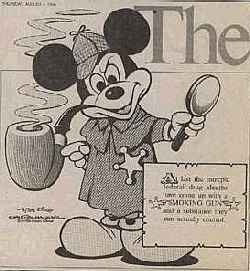
So what exactly happened with Sherlock Holmes and John Watson in the past few months? It all starts with the eccentricities of US copyright law, in which a standard international “creator’s life plus seventy years” term sits uneasily alongside a fixed “ninety-five years from publication” term (this is due to what are sometimes known as the “Mickey Mouse Laws,” as they were pushed pretty hard by Disney’s lobbyists). Arthur Conan Doyle died in 1930; in the UK and most of the world, his work entered the public domain in the year 2000. But in the US, with that fixed-term copyright, not all the stories went at the same time. The Holmes stories were published from 1887 to 1927, with the last ten stories appearing as a block in The Last Case-Book of Sherlock Holmes, and for the last few years, while dozens of stories and all four novels have been public domain, the Doyle estate has held on to that last collection. It only really applies if you’re selling books in the States, but that’s a pretty big market.
So that just means you can’t publish The Complete Sherlock Holmes in the States without permission, right? Not quite. The Doyle estate has aggressively pursued every publisher, TV company and film-maker trying to use the characters, threatening legal action if they don’t pay a licence. And since the licence fees weren’t onerous, most people have paid rather than fight (this happens in copyright disputes more often than you think). Most people, that is, except Leslie Klinger, whose collection of new Holmes stories, In the Company of Sherlock Holmes, is due out this November. Klinger called shenanigans and went to court. The Doyle estate’s argument? That Holmes and Watson are “round” characters, and unlike “flat” characters, who are fully formed when they first appear in writing, the famous detective and his friend didn’t become fully “round” until the last stories were published. Ergo, anyone using the characters is drawing on those last few stories and infringing copyright.
The Doyle estate lost. They went to appeal, in the Seventh Circuit Court (beats me what that actually is) in June, and lost hard. Judge Richard Posner wonderfully called their argument “novel,” suggested their appeal “bordered on the quixotic,” and said that as long as you don’t mention anything from those stories (basically, Holmes’s feelings about dogs, his experience playing rugby, and Watson’s second wife), you’re fine. Then Klinger countersued for legal expenses, and Posner granted them this Monday, putting the boot in a little deeper, accusing the estate of “extortion” and suggesting they’d violated antitrust laws by instructing Amazon to pull sales of disputed titles. There’s still the Supreme Court to go, but basically, Posner’s saying: “You’ve lost, guys. Stay down.”
What does this mean for us? To be honest, we’d made the decision to go ahead with Two Hundred and Twenty-One Baker Streets before this even happened. “Flat” or “round,” the characters in our collection are pastiches, and we’re pretty sure the Doyle estate’s arguments would struggle to apply to our versions of Holmes and Watson. More importantly, though, we’re big believers in the act of creation and – although as publishers we should be all about the IP control – we know that creation has a lot to do with homage, reinvention and revision. Let a creator exploit his work for a fair period, but then allow it to become part of the weave that other creators draw upon. This is a great step forward, and our support goes out to Klinger and his publishers for having the courage to balls it out.

Two Hundred and Twenty-One Baker Streets publishes October 2014 from Abaddon Books.


